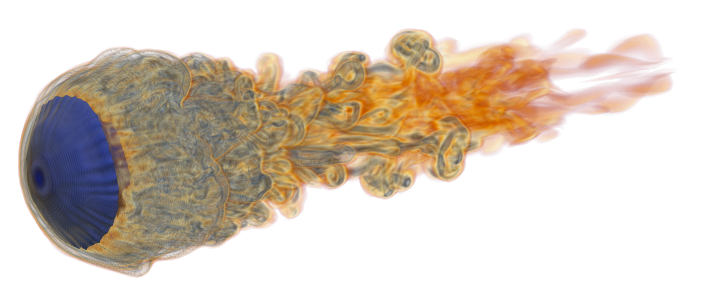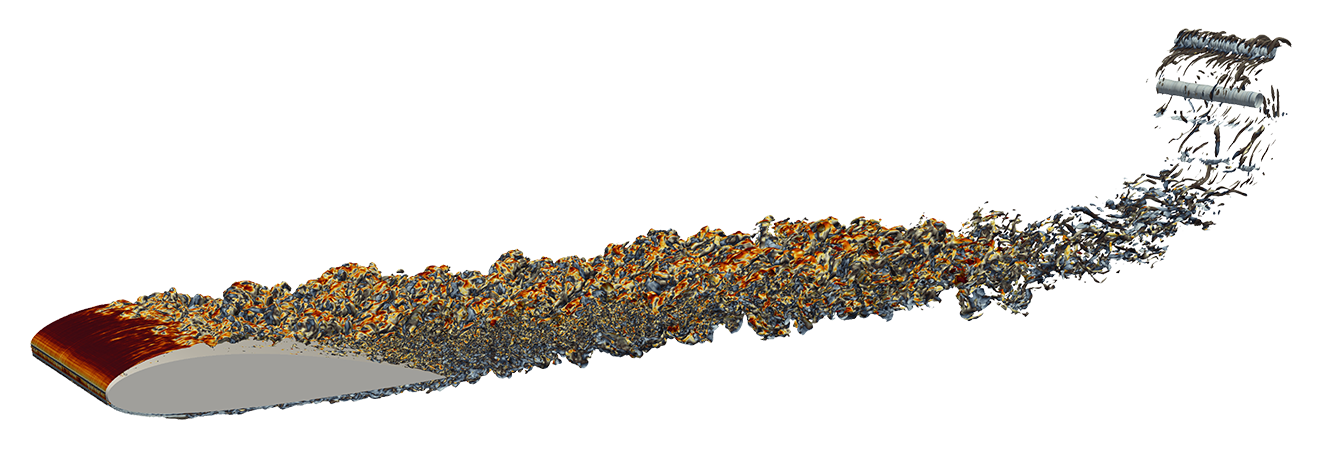Welcome to the home of MFC! MFC simulates compressible multi-component and multi-phase flows, amongst other things. MFC is written in Fortran and uses metaprogramming to keep the code short (about 20K lines).
MFC is used on the latest leadership-class supercomputers. It scales ideally to exascale; tens of thousands of GPUs on NVIDIA- and AMD-GPU machines on Oak Ridge Summit and Frontier. MFC is a SPEChpc benchmark candidate, part of the JSC JUPITER Early Access Program, and used OLCF Frontier and LLNL El Capitan early access systems.
Get in touch with Spencer if you have questions! We have an active Slack channel and development team. MFC has high-level documentation, visualizations, and more on its website.
We keep many examples.
Here's one!
MFC can execute high-fidelity simulations of shock-droplet interaction (see examples/3d_shockdroplet)
Another example is the high-Mach flow over an airfoil, shown below.
You can navigate to this webpage to get started using MFC! It's rather straightforward. We'll give a brief intro. here for MacOS. Using brew, install MFC's dependencies:
brew install coreutils python cmake fftw hdf5 gcc boost open-mpiYou're now ready to build and test MFC! Put it to a convenient directory via
git clone https://github.com/MFlowCode/MFC
cd MFCand be sure MFC knows where to find Boost by appending to your dotfiles and sourcing them again
echo -e "export BOOST_INCLUDE='$(brew --prefix --installed boost)/include'" | tee -a ~/.bash_profile ~/.zshrc
. ~/.bash_profile 2>/dev/null || . ~/.zshrc 2>/dev/null
! [ -z "${BOOST_INCLUDE+x}" ] && echo 'Environment is ready!' || echo 'Error: $BOOST_INCLUDE is unset. Please adjust the previous commands to fit with your environment.'then you can build MFC and run the test suite!
./mfc.sh build -j $(nproc)
./mfc.sh test -j $(nproc)And... you're done!
You can learn more about MFC's capabilities via its documentation or play with the examples located in the examples/ directory (some are shown here)!
The shock-droplet interaction case above was run via
./mfc.sh run -n $(nproc) ./examples/3d_shockdroplet/case.py where $(nproc) is the number of cores the example will run on (and the number of physical cores on your CPU device).
You can visualize the output data in examples/3d_shockdroplet/silo_hdf5 via Paraview, Visit, or your favorite software.
OLCF Frontier is the first exascale supercomputer. The weak scaling of MFC on this machine shows near-ideal utilization.
MFC has many features. They are organized below. Just click the drop-downs!
Physics
- 1-3D
- Compressible
- Low Mach number treatment available
- Multi- and single-component
- 4, 5, and 6 equation models for multi-component/phase features
- Kapila and Allaire models 5-equation models
- Multi- and single-phase
- Phase change via p, pT, and pTg schemes
- Grids
- 1-3D Cartesian, cylindrical, axisymmetric.
- Arbitrary grid stretching for multiple domain regions.
- Complex/arbitrary geometries via immersed boundary method
- STL geometry files supported
- Surface tension for multiphase cases
- Sub-grid Euler-Euler multiphase models for bubble dynamics and similar
- Viscous effects (high-order accurate representations)
- Ideal and stiffened gas equations of state
- Body forces
- Acoustic wave generation (one- and two-way sound sources)
Numerics
- Shock and interface capturing schemes
- First-order upwinding
- WENO reconstructions of order 3, 5, and 7
- WENO variants: WENO-JS, WENO-M, WENO-Z, TENO
- Monotonicity-preserving reconstructions
- Reliable handling of large density ratios
- Exact and approximate (e.g., HLL, HLLC) Riemann solvers
- Boundary conditions
- Periodic, reflective, extrapolation/Neumann
- Slip and no-slip
- Thompson-based characteristic BCs: non-reflecting sub/supersonic buffers, inflows, outflows
- Generalized characteristic relaxation boundary conditions
- Runge-Kutta orders 1-3 (SSP TVD)
- Interface sharpening (THINC-like)
Large-scale and accelerated simulation
- GPU compatible on NVIDIA (P/V/A/H100, GH200, etc.) and AMD (MI200+) hardware
- Ideal weak scaling to 100% of the largest GPU supercomputers
- >10K NVIDIA GPUs on OLCF Summit (NV V100-based)
- >66K AMD GPUs on the first exascale computer, OLCF Frontier (AMD MI250X-based)
- Near compute roofline behavior
- RDMA (remote data memory access; GPU-GPU direct communication) via GPU-aware MPI on NVIDIA (CUDA-aware MPI) and AMD GPU systems
Software robustness and other features
- Fypp metaprogramming for code readability, performance, and portability
- Continuous Integration (CI)
- >250 Regression tests with each PR.
- Performed with GNU (GCC), Intel, Cray (CCE), and NVIDIA (NVHPC) compilers on NVIDIA and AMD GPUs.
- Line-level test coverage reports via Codecov and
gcov
- Benchmarking to avoid performance regressions and identify speed-ups
- >250 Regression tests with each PR.
- Continuous Deployment (CD) of website and API documentation
If you use MFC, consider citing it as:
@article{Bryngelson_2021,
title = {{MFC: A}n open-source high-order multi-component, multi-phase, and multi-scale compressible flow solver},
author = {S. H. Bryngelson and K. Schmidmayer and V. Coralic and J. C. Meng and K. Maeda and T. Colonius},
journal = {Computer Physics Communications},
year = {2021},
volume = {266},
pages = {107396},
doi = {10.1016/j.cpc.2020.107396}
}@article{Radhakrishnan_2024,
title = {Method for portable, scalable, and performant {GPU}-accelerated simulation of multiphase compressible flow},
author = {A. Radhakrishnan and H. {Le Berre} and B. Wilfong and J.-S. Spratt and M. {Rodriguez Jr.} and T. Colonius and S. H. Bryngelson},
journal = {Computer Physics Communications},
year = {2024},
volume = {302},
pages = {109238},
doi = {10.1016/j.cpc.2024.109238}
}Copyright 2021 Spencer Bryngelson and Tim Colonius. MFC is under the MIT license (see LICENSE for full text).
Multiple federal sponsors have supported MFC development, including the US Department of Defense (DOD), National Institutes of Health (NIH), Department of Energy (DOE), and National Science Foundation (NSF).
MFC computations have used many supercomputing systems. A partial list is below
- OLCF Frontier and Summit, and testbed systems Wombat, Crusher, and Spock (allocation CFD154, PI Bryngelson)
- LLNL Lassen and El Capitan testbed system, Tioga
- PSC Bridges(1/2), NCSA Delta, SDSC Comet and Expanse, Purdue Anvil, TACC Stampede(1-3), and TAMU ACES via ACCESS-CI (allocations TG-CTS120005 (PI Colonius) and TG-PHY210084 (PI Bryngelson))
- DOD systems Onyx, Carpenter, and Nautilus via the DOD HPCMP program
- Sandia National Labs systems Doom and Attaway and testbed systems Weaver and Vortex



